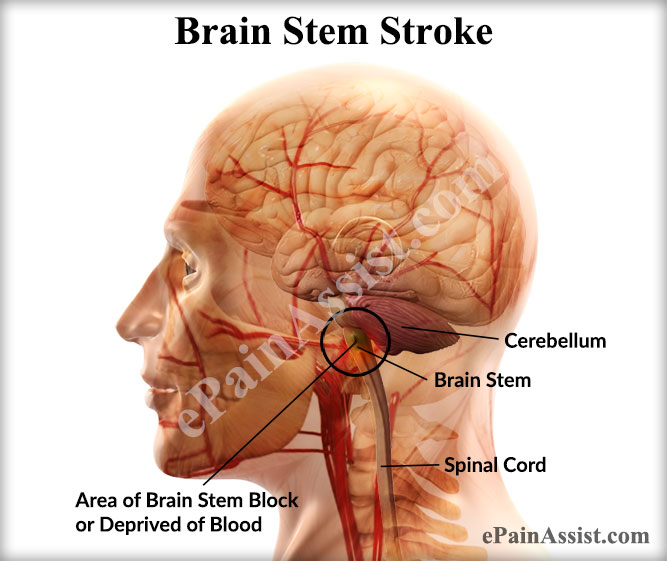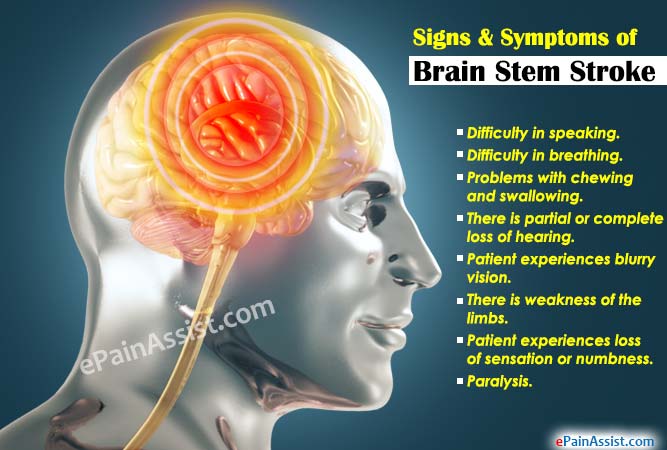What is a Brain Stem Stroke?
A person is said to have suffered from a stroke when there is any interference or interruption in the blood supply to the brain. The manner in which the brain or the patient is affected from a stroke depends on the severity of the brain damage and the area of the brain which has been damaged.
The symptoms of a brain stem stroke are more serious and complex than other strokes. The brain stem is present just above the spinal cord and is half-a-inch in diameter. The brain stem is responsible for controlling all the basic activities of the central nervous system, such as consciousness, breathing, blood pressure, swallowing, speech, heartbeat, eye movements and hearing. Various impulses, which are sent by different parts of the brain travel to other parts of the body, via the brain stem. We depend on the function of our brain stem for our survival. A brain stem stroke can be fatal and poses danger to important functions of our body, thus making it a life-threatening condition.
Symptoms of a stroke depend on the area of the brain which is affected. A brain stem stroke causes disturbances in vital functions, such as heartbeat and breathing along with other involuntary functions, such as swallowing and eye movements. Hearing and speech are also affected from a brainstem stroke. Brain stem stroke can also cause loss of taste and smell in the patient.

Causes of Brain Stem Stroke
The cause of a brain stem stroke is same as the causes of other strokes, which includes anything that disturbs the blood supply to the brain stem. This includes a blood clot or accumulation of blood in the brain after a blood vessel has ruptured. Ischemic stroke is the most common type of stroke. It is caused by a blood clot. The formation of a clot can occur in the artery, which supplies blood to the brain. Formation of clot in other areas can also occur after which the clot can travel via blood vessels and can eventually get lodged in the vessel which supplies the brain.
Hemorrhagic stroke is another type of stroke which occurs when there is rupture of a blood vessel resulting in pooling and accumulation of the blood leading to increased pressure in the brain causing stroke.
Risk Factors of Brain Stem Stroke
- Aging or older individuals are at an increased risk of a brain stem stroke although anyone can have a stroke.
- Having a family history of a mini-stroke or a stroke increases the risk of a brain stem stroke.
- Males and individuals of African-American, Asian/Pacific Islander or Hispanic descent are at a higher risk for a brain stem stroke.
- Medical conditions, such as hypertension, diabetes, high cholesterol, cardiovascular disease and some blood disorders increase the risk of a brain stem stroke.
- Some autoimmune diseases, cancer and pregnancy also increase the risk of a brain stem stroke.
- Use of birth control pills and long-term hormone replacement therapy, especially in women who are above the age of 35 and who smoke, are at a higher risk for a stroke.
- Smoking and sedentary lifestyle increases the risk of a brainstem stroke.
- Alcohol and drug (heroin, cocaine, amphetamines) abuse increases the risk of a brain stem stroke.
Complications of Brain Stem Stroke
Complications of brain stem stroke are the same as complications of other stroke including impaired breathing and loss of consciousness. Locked-in syndrome and coma is a serious complication of brain stem stroke. Locked-in syndrome is a condition where the entire body, except for the eye muscles, becomes paralyzed. Patient retains the ability to think and communicates only through eye movements, such as blinking. Patients with locked-in syndrome usually need a gastric tube, tracheostomy tube and a catheter to help with their normal functions of the body. In such cases, communication system is established with the patient, which involves the use of eye movement, such as blinking. Around 1% of stroke patients can suffer from psychosis in the form of delusions or hallucinations.

Signs & Symptoms of Brain Stem Stroke
Two of the most common symptoms of a brain stem stroke are vertigo and dizziness and they usually occur together. In brain stem stroke, these two symptoms may not be accompanied by weakness on one side of the body, as seen in other types of stroke. Other common symptoms of a brain stem stroke include:
- Difficulty in speaking.
- Difficulty in breathing.
- Problems with chewing and swallowing.
- There is partial or complete loss of hearing.
- Patient experiences blurry vision.
- There is weakness of the limbs.
- Patient experiences loss of sensation or numbness.
- Paralysis.
Diagnosis of Brain Stem Stroke
A brain stem stroke is a life-threatening condition and a medical emergency. The diagnosis of a brain stem stroke can be difficult, as its symptoms are more complex than other strokes. It is very important to diagnose a brain stem stroke as soon as possible. The following steps are taken to confirm the diagnosis of brain stem stroke:
- The patient’s nervous system response is assessed along with the heart function, and the blood oxygen levels.
- Computed tomography (CT) scan is done to check the blood vessels in the brain.
- Magnetic resonance imaging (MRI) of the brain and neck can also be done.
- Doppler ultrasound is done, if a torn or burst blood vessel is suspected, to see if all the vessels are intact.
- Electrocardiogram and echocardiogram are done to assess the heart function.
- Other diagnostic testing includes blood tests, kidney and liver function tests.
Treatment of Brain Stem Stroke
Treatment for and recovery from Brain Stem Stroke is more challenging due to the loss of more basic life functions. Fundamental things like breathing and swallowing are instinctive and involuntary in humans and are done without a conscious thought. In a brain stem stroke, the patient has to re-train and re-learn all these things. As one can see, the process of re-learning how to breathe or swallow is very different and more difficult than that of re-learning the use of a hand.
Initial Treatment for Brain Stem Stroke
If the cause of the brain stem stroke is a blood clot, then the first step of treatment comprises of dissolving the clot and restoring the blood flow. Tissue plasminogen activator (tPA) are the drugs, which are specifically used in dissolving the blood clots. These medicines are administered intravenously. For this treatment to be effective, this medicine should be given within three hours of appearance of the brainstem stroke symptoms.
If a ruptured blood vessel has caused the stroke, then stopping the internal bleeding is the priority. It is also important to ensure that the heart and lung functions are stable.
Treatment for Ischemic Brain Stem Strokes
- The causes of ischemic strokes of the brain stem are torn vessels or blood clots. This type of stroke requires medications for preventing clots in the future and also to thin the blood so the blood circulation becomes easier and so does the breaking up of any existing clots.
- Medicines can also be prescribed for high blood pressure, irregular heartbeats and high cholesterol.
- Carotid endarterectomy can be done to remove the fat deposits from the arteries. Embolectomy is a procedure where a catheter is used to remove the clots.
- Angioplasty and stenting can also be done for widening of the artery.
Treatment for Hemorrhagic Brain Stem Stroke
- The causes for hemorrhagic strokes in the brain are burst or ruptured blood vessels and the first line of treatment is to stop the bleeding.
- Medicines are given which prevent the blood thinning and also control the blood pressure. Medicines are also prescribed which mitigate the effects of the bleeding in the brain stem.
- In case of an aneurysm, surgery is needed to stop the bleeding where a coil or clip is placed in order to stop the bleeding.
Prognosis & Life Expectancy in Brain Stem Stroke
A brain stem stroke is a serious condition and causes long-term problems. The prognosis for brain stem stroke differs from patient to patient. Prognosis for a brain stem stroke largely depends on the time it takes to diagnose the condition and initiate the treatment. The sooner this condition is diagnosed and the sooner the treatment is started, the better is the prognosis for a brain stem stroke. If blood flow to the brain stem is restored within a few hours, then the treatment options are more and the chances of a full recovery for the patient are also more.
The survival rate or life expectancy for a brain stem stroke patient is higher if the stroke is classified as ischemic. The life expectancy of majority of the patients with locked-in syndrome is about 10 years or more after having brain stem stroke.
It is important to continue medications and therapy for the patient’s remaining life. Physical therapy is needed to regain the patient’s motor skills. Occupational therapy is also required to help the patient with his/her daily tasks of living. Speech therapy helps in improving speech and regaining control over swallowing. Brain stem stroke survivors are often left with severe disabilities. Psychological counseling is needed to help them adjust to their new life.
Recovery & Rehabilitation in Brain Stem Stroke
The prognosis and recovery for patients suffering from locked-in syndrome due to brain stem stroke is different and more difficult. Patients suffering from locked-in syndrome require a huge amount of assistance from medical professionals, as well as family members, and most of the times for the rest of their lives. After brain stem stroke, if the patient is suffering from locked-in syndrome, then they need to undergo: Bladder retraining, speech therapy, occupational therapy and physical therapy.
Some patients gradually regain sufficient bladder function over a period of time so that the urinary catheter tube can be removed. Some patients can also regain some amount of movement. Rarely, patients may recover enough to talk and walk. The life expectancy of majority of the patients with locked-in syndrome is about 10 years or more after having a brain stem stroke.
- Adeoye, O., Hornung, R., Khatri, P., Kleindorfer, D., & Woo, D. (2011). Recombinant tissue-type plasminogen activator use for ischemic stroke in the United States. Stroke, 42(7), 1952-1955. doi:10.1161/STROKEAHA.111.619003
- Broderick, J. P., & Palesch, Y. Y. (2003). Recombinant tissue-type plasminogen activator (Alteplase) for ischemic stroke 3 to 5 hours after symptom onset. Stroke, 34(5), 1435-1438. doi:10.1161/01.str.0000065737.87773.22
- Hacke, W., Kaste, M., Bluhmki, E., Brozman, M., Dávalos, A., Guidetti, D., . . . Thrombolysis with Alteplase 3 to 4.5 Hours after Acute Ischemic Stroke. New England Journal of Medicine, 359(13), 1317-1329. doi:10.1056/nejmoa0804656
- Marler, J. R., Tilley, B. C., Lu, M., Brott, T. G., Lyden, P. C., Grotta, J. C., . . . Global Burden of Stroke Investigators. (2000). Early stroke treatment associated with better outcome: The NINDS rt-PA stroke study. Neurology, 55(11), 1649-1655. doi:10.1212/wnl.55.11.1649
- Saver, J. L., Goyal, M., Bonafe, A., Diener, H. C., Levy, E. I., Pereira, V. M., . . . Jovin, T. G. (2015). Stent-retriever thrombectomy after intravenous t-PA vs. t-PA alone in stroke. New England Journal of Medicine, 372(24), 2285-2295. doi:10.1056/NEJMoa1415061
Also Read:
- What Can Cause Brief Loss of Consciousness and is it a Sign of Stroke?
- Acute Ischemic Stroke: Causes, Symptoms, Treatment- Anticoagulants, Corticosteroids
- Types of Stroke: Ischemic Stroke, Hemorrhagic Stroke, TIA
- Detecting Stroke: Can You Feel a Stroke Coming On?
- Hemorrhagic Stroke: Symptoms, Treatment, Recovery, Survival, Causes, Types, Prognosis
- Silent Stroke: What You Need to Know
- Stroke vs Dementia: Differences Worth Knowing
- What Puts You at Risk for a Stroke & How to Reduce the Risk Factors of Stroke?
